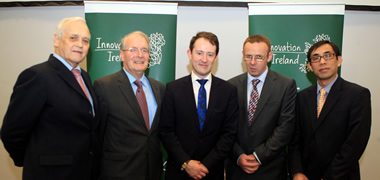University of Ireland, Galway (NUIG)
Scientists in Galway have made a significant discovery with genetic disease
The five NUI Galway Researchers are Professor Robert Lahue, Dr David Finn, Professor Malini Olivo, Dr Wexnin Wang and Dr Ciaran Morrison.
RESEARCHERS AT National University of Ireland, Galway (NUIG) say they have made a “significant” discovery in the treatment of Huntington’s disease, an incurable inherited condition which affects the brain and muscular functions.
The findings, which were published yesterday in international journal PLoS Biology, suggest that inhibiting specific enzymes could slow down progression of the disease.
Huntington’s affects more than 100,000 people across the globe, with up to 500 people diagnosed with the condition in Ireland and more than 2,000 at risk of contracting it.
One of the best-known sufferers was American folk musician Woody Guthrie, who was initially believed to have either alcoholism or schizophrenia before it was confirmed that he had inherited Huntington’s from his mother. He died from the condition in 1967.
US-based scientist Michael Conneally, who is originally from Galway, is credited with identifying the gene in 1993.
Currently the available treatments are designed to manage symptoms of the condition, which can involve uncontrolled movement, emotional disturbance and severe mental deterioration.
The new research at the Galway university notes that specific enzymes called histone deacetylase complexes (HDACs) are “positive agents” in cell mutation which is a major factor in Huntington’s disease.
When these enzymes are active, they are believed to make the condition more severe. The NUIG team, led by Prof Robert Lahue of the Centre for Chromosome Biology, has found the risk of further mutation can be reduced by blocking the enzymes with experimental drugs.
“Our discovery suggests that inhibiting HDAC function slows down the mutation process, and thereby could slow disease progression,” Prof Lahue has said.
Pinpointing the specific enzymes for “selective inhibition” was a key finding in the research, he said.
The new inhibitors are currently being tested in several laboratories in the US, and Prof Lahue and his team hope to work with them to evaluate their effects.
Will plain packaging be the key to making cigarette smoking less appealing to children?


Behind the bike sheds: A quarter of all under-15s have tried smoking once (models posed above)
Almost 160,000 children start smoking every year in the UK – enough to fill around 5,200 classrooms, a charity has warned.
The 157,000 children aged 11 to 15 who take up the habit every year could also make up 14,000 junior football teams, according to Cancer Research UK.
The charity, which supports a move to plain packaging for tobacco, says eight out of 10 people start smoking before they are 19 and more must be done to prevent youngsters starting.
The data refers to the proportion of children in an age group who were smoking a year after first saying they were smokers.
Almost a million under-15s – more than a quarter (27 per cent) of all children – have tried smoking at least once .
Among 12-year-olds alone, 1 per cent were smoking regularly in 2009, another 2 per cent smoked occasionally and 2 per cent said they used to smoke.
A year later in 2010, as 13-year-olds, 3 per cent of children smoked regularly, 2 per cent smoked occasionally and 4 per cent used to smoke.
Jean King, Cancer Research UK’s director of tobacco control, said: ‘Far too many young people start smoking every year. We must act to bring this number down.
‘The tobacco industry spends a great deal of money on designing cigarettes and their packets so they seem glamorous, appealing, fashionable and attractive in an effort to recruit more customers.
‘With advertising outlawed, the cigarette packet is now the most important marketing tool the tobacco industry has.
‘Our research has shown that selling all cigarettes in standardised packs will help reduce the appeal of smoking and give children one less reason to start smoking.’
Charity data suggests that children who smoke just one cigarette by the age of 11 are around twice as likely to take up smoking over the next few years as those who do not try the habit.
A father of four said he ‘started smoking because it was considered cool’ and later switched from cigarettes to cigars due to the ‘lure’ of advertising.
‘In 2010 I woke up one morning full of aches and pains which I assumed was the start of flu.
‘I’d always been very fit so I decided to nip it in the bud by going to the doctor.
‘My GP was concerned by some blood tests so I had an X-ray which revealed a shadow on the lung and this turned out to be lung cancer.
‘The toughest day of my life was sitting each of my children down and telling them I had lung cancer.’
Mr Richardson said his treatment seems to be working, adding: ‘I feel as if I’ve been given a second chance.
‘I know first-hand how horrific lung cancer is and how it’s almost always preventable by not smoking in the first place.
‘My wife Di and I run children’s day nurseries and out-of-school clubs in Hexham and Prudhoe caring for young children.
‘I would hate to think that any of the hundreds of children we have looked after might ever go through what I have because they were tempted by one glitzy packet attempting to make smoking look cool.’


No comments:
Post a Comment